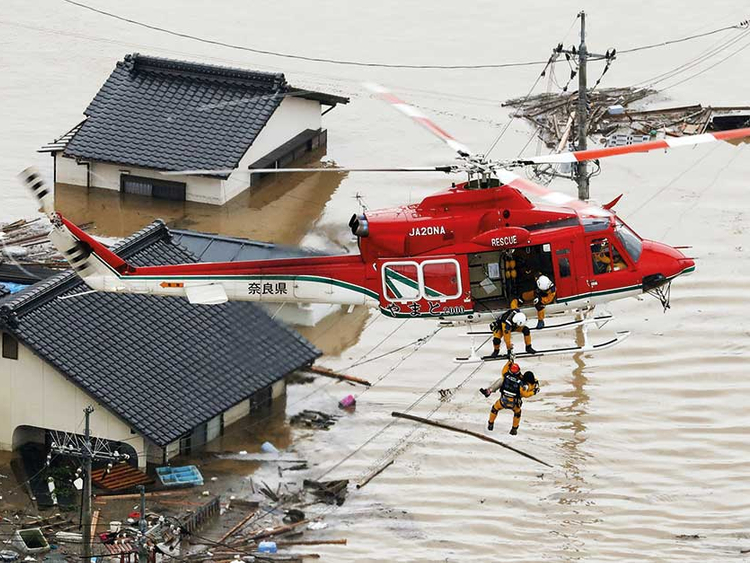
Tokyo: At least 85 people have died and 58 are unaccounted for as torrential rains continued to batter parts of western Japan on Sunday, causing landslides and flooding and forcing millions of people from their homes, local media reported.
Television footage showed bridges and cars washed away by raging rivers and floodwaters, with people perched on the roofs of their homes, surrounded by water and awaiting rescue.
Japan's Meteorological Agency had issued rare "emergency warnings" against landslides, rising rivers, strong winds and lightning strikes caused by what it called "historic" rains in 23 prefectures across the western and central parts of the country. The rains began Thursday and continued into Sunday in many areas.
Such warnings are issued in anticipation of the sort of extreme conditions that occur just once or twice in 50 years, Kyodo News reported.
"There are still many people missing and others in need of help. We are working against time," Prime Minister Shinzo Abe said Sunday morning.
Among the missing was a nine-year-old boy believed trapped in his house by a landslide that killed at least three others, one of them a man in his 80s.
Helicopter footage showed people on their roofs waving for help in Kurashiki, and soldiers rescuing children by boat from a flooded river in Hiroshima.
In Motoyama, a town on Shikoku island, about 600 km from the capital,Tokyo, 583mm of rain fell between Friday and Saturday morning, the agency said.
Japan's government set up an emergency management centre at the prime minister's office and some 54,000 rescuers from the military, police and fire departments were dispatched across a wide swath of southwestern and western Japan.
"There are still many people missing and others in need of help, we are working against time," Prime Minister Shinzo Abe said.
Emergency warnings for severe rain remained in effect for three prefectures, with 300 mm (11 inches) predicted to fall by Monday morning in parts of the smallest main island of Shikoku.
Evacuation orders remained in place for some 2 million people and another 2.3 million were advised to evacuate, although rain had stopped and floodwaters receded in some areas.
Among the dead were a man who fell from a bridge into a river in western Hiroshima city, and a 77-year-old man in Takashima, 56 km east of the ancient capital of Kyoto, who was swept into a canal as he worked to remove debris, NHK said.
Four people in Ehime, Hiroshima and Yamaguchi prefectures were in critical condition after being injured in landslides, it added.
Roads closed, train services suspended
The rain began late last week as the remnants of a typhoon fed into a seasonal rainy front, with humid, warm air pouring in from the Pacific making it still more active - a pattern similar to one that set off flooding in southwestern Japan exactly a year ago that killed dozens. The front then remained in one place for an unusually long time, the JMA said.
Roads were closed and train services suspended in parts of western Japan. Shinkansen bullet train services, resumed on a limited schedule after they were suspended on Friday.
Automakers including Mazda Motor Corp and Daihatsu Diesel Manufacturing Co suspended operations at several plants on Saturday due to a shortage of parts or dangerous conditions. They were set to decide later on Sunday on plans for the coming week.
Electronics maker Panasonic Corp said one plant in Okayama, western Japan, could not be reached due to road closures, although it had been closed for the weekend anyway. A decision about next week would be made on Monday.
While the Japanese government monitors weather conditions closely and issues warnings from an early stage, the fact that much of the country outside major cities is mountainous and building takes place on virtually every bit of usable land leaves it vulnerable to disasters.
Reforestation policies after the Second World War that saw many mountains logged and replanted with trees whose roots are less able to retain water have also contributed to the danger.













